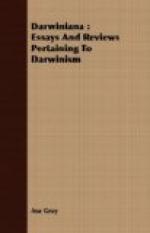FOOTNOTES:
I-1. “On the Origin of Species by Means
of Natural Selection, or the
Preservation of Favored Races in the Struggle for
Life,” by Charles Darwin,
M.A., Fellow of the Royal, Geological, Linnaean, etc.,
Societies, Author of
“Journal of Researches during H. M. S. Beagle’s
Voyage round the World.”
London: John Murray. 1859. 502 pp., post 8vo.
I-2. Article in this Journal, vol. xxiv., p. 305.
I-3. “Species tot sunt, quot diversas formas ab initio produxit Infinitum Ens; quae formae secundum generationis inditas leges, produxere plures, at sibi semper similes.”—Linn. Phil. Bot., 99, 157.
I-4. Agassiz, “Essay on Classification; Contributions to Natural History,” p. 132, et seq.
I-5. As to this, Darwin remarks that he can only hope to see the law hereafter proved true (p. 449); and p. 338: “Agassiz insists that ancient animals resemble to a certain extent the embryos of recent animals of the same classes; or that the geological succession of extinct forms is in some degree parallel to the embryological development of recent forms. I must follow Pictet and Huxley in thinking that the truth of this doctrine is very far from proved. Yet I fully expect to see it hereafter confirmed, at least in regard to subordinate groups, which have branched off from each other within comparatively recent times. For this doctrine of Agassiz accords well with the theory of natural selection.”
I-6. Op. cit., p. 131.—One or two Bridgewater Treatises, and most modern works upon natural theology, should have rendered the evidences of thought in inorganic Nature not “unexpected.”
I-7. Volume xvii. (2), 1854, p. 13.
I-8. We suspect that this is not an ultimate
fact, but a natural consequence
of inheritance—the inheritance
of disease or of tendency to disease,
which close interbreeding perpetuates
and accumulates, but wide
breeding may neutralize or eliminate.
I-9. The rules and processes of breeders of animals, and their results, are so familiar that they need not be particularized. Less is popularly known about the production of vegetable races. We refer our readers back to this Journal, vol. xxvii., pp. 440—442 (May, 1859), for an abstract of the papers of M. Vilmorin upon this subject.




